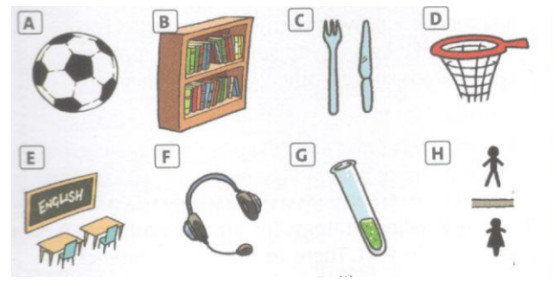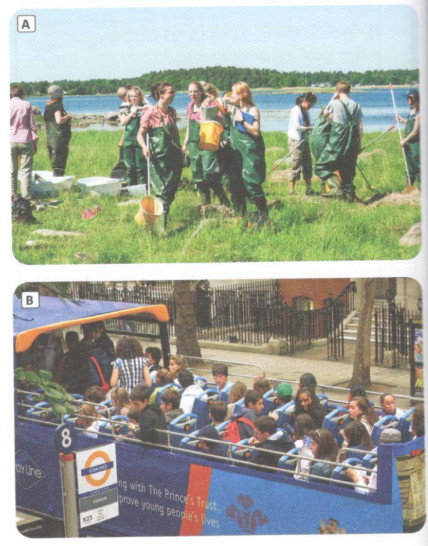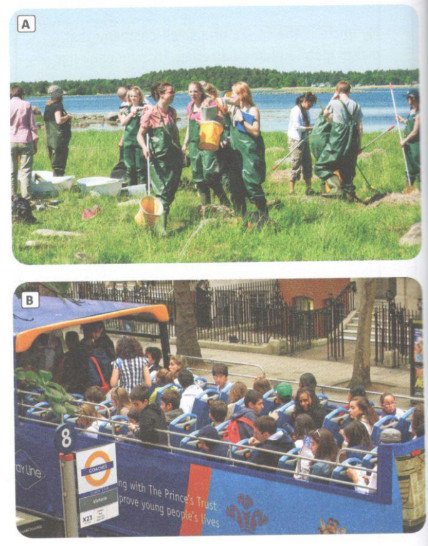6G - Unit 6. Money - SBT Tiếng Anh 10 Friends Global
1. Match the symbols (A -H) with the parts of the school (1-8) below. 2. Match the phrases below with categories A – D. 3. Listen to a student presenting her answer to the task below. 4. Read the Speaking Strategy. Then listen again. Which of the phrases in exercise 2 does the student use? 5. Now prepare to do the task below. Make notes. 6. Now do the task from exercise 5 using your notes.
Bài 1
1. Match the symbols (A-H) with the parts of the school (1-8) below.
(Nối những biểu tượng (A-H) với các thành phần của ngôi trường (1-8) dưới đây.)

1. canteen ____________
2. classroom ____________
3. gym ____________
4. language lab ____________
5. library ____________
6. playing field ____________
7. science lab ____________
8. toilets ____________
Phương pháp giải:
Nghĩa của từ vựng
1. canteen: canteen
2. classroom: lớp học
3. gym: phòng gym
4. language lab: phòng học ngôn ngữ
5. library: thư viện
6. playing field: sân chơi
7. science lab: phòng thí nghiệm kho học
8. toilets: nhà vệ sinh
Lời giải chi tiết:
| 1. C | 2. G | 3. D | 4. F | 5. B | 6. A | 7. G | 8. H |
Bài 2
2. Match the phrases below with categories A – D.
(Nối các cụm từ bên dưới với danh mục A – D)
A. Structuring your speech
B. ordering points or opinions
C. justifying your opinions
D. summing up your opinion
All in all, … ◻
First, … Second, … Finally, … ◻
First of all, we need to decide / examine / look at / ask ourselves … ◻
I’d like to start by saying / looking at … ◻
Just to summarise the main points … ◻
Now I’d like to move on to … ◻
Now let’s look at / move on to (the question of) … ◻
The main reason I feel this way is … ◻
There are a number of reasons why I believe this. First, …◻
I’ll begin with … ◻
This leads to my next point. ◻
The reason I say that is … ◻
I’ll tell you why I think that. ◻
To sum up, … In conclusion, … ◻
Phương pháp giải:
Dịch nghĩa
All in all, … : tóm lại
First, … Second, … Finally, … : đầu tiên,…thứ 2,… cuối cùng,…
First of all, we need to decide / examine / look at / ask ourselves … : Trước hết, chúng ta cần phải quyết định / kiểm tra / xem xét / tự hỏi bản thân mình…
I’d like to start by saying / looking at …: Tôi muốn bắt đầu bằng cách nói / nhìn vào…
Just to summarise the main points …: Chỉ để tóm tắt những điểm chính…
Now I’d like to move on to …: Bây giờ tôi muốn chuyển sang…
Now let’s look at / move on to (the question of) … : Bây giờ chúng ta hãy xem xét / chuyển sang (câu hỏi về)…
The main reason I feel this way is … : Lý do chính mà tôi cảm thấy theo cách này là…
There are a number of reasons why I believe this. First, …: Có một số lý do tại sao tôi tin vào điều này. Ngày thứ nhất, ...
I’ll begin with … : Tôi sẽ bắt đầu với…
This leads to my next point: Điều này dẫn đến điểm tiếp theo của tôi
The reason I say that is … : Lý do tôi nói điều đó là…
I’ll tell you why I think that: Tôi sẽ cho bạn biết tại sao tôi nghĩ như vậy
To sum up, … In conclusion, … : Tóm lại,…
Lời giải chi tiết:
A. Structuring your speech
(Nêu cấu trúc bài phát biểu của bạn)
First of all, we need to decide / examine / look at / ask ourselves …
I’d like to start by saying / looking at …
Now I’d like to move on to …:
Now let’s look at / move on to (the question of) …
I’ll begin with …
This leads to my next point
B. Ordering points or opinions
(Thứ tự các điểm hoặc ý kiến)
First, … Second, … Finally, …
C. Justifying your opinions
(Biện minh cho ý kiến của bạn)
There are a number of reasons why I believe this. First, …:
The reason I say that is …
I’ll tell you why I think that
The main reason I feel this way is …
D. Summing up your opinion
(Kết luận ý kiến của bạn)
Just to summarise the main points …
To sum up, … In conclusion, …
Bài 3
3. Listen to a student presenting her answer to the task below.
(Nghe một học sinh trình bày câu trả lời của cô ấy cho nhiệm vụ dưới đây.)
The government does not spend enough money on schools. Do you agree? Why? / Why not?
(Chính phủ không chi đủ tiền cho các trường học. Bạn có đồng ý không? Tại sao? / Tại sao không?)
Phương pháp giải:
Bài nghe
I'd like to start by looking at my school. It’s clear that the school doesn't have much money. There are a number of reasons why I say that. First of all, we don't have enough computers, and the ones we have are rather old. Secondly, there aren't many books in the library. And thirdly, the buildings are very old and need some repairs. Last winter when it rained heavily, water leak in from the roof of the chin. It’s true that people always want more money for education, but I think the government should listen to them and give schools more money. The main reason why I feel this way is the education is important for the future of our country. So, in conclusion, it’s clear that schools don't have enough computers and books; and the buildings are often old. The government definitely needs to spend more money on education.
Bài dịch
Tôi muốn bắt đầu bằng cách nhìn vào trường học của tôi. Rõ ràng là trường không có nhiều tiền, có một số lý do khiến tôi nói như vậy. Trước hết, chúng tôi không có đủ máy tính, và những cái chúng tôi có đã khá cũ. Thứ hai, không có nhiều sách trong thư viện. Và thứ ba, các tòa nhà đã rất cũ và cần được sửa chữa lại. Mùa đông năm ngoái, trời mưa to, nước dột từ mái tôn xuống. Đúng là mọi người luôn muốn có nhiều tiền hơn cho giáo dục, nhưng tôi nghĩ chính phủ nên lắng nghe họ và cung cấp cho các trường học nhiều tiền hơn. Lý do chính khiến tôi cảm thấy theo cách này là giáo dục rất quan trọng đối với tương lai của đất nước chúng ta. Vì vậy, kết luận, rõ ràng là các trường học không có đủ máy tính và sách; và các tòa nhà thường cũ. Chính phủ chắc chắn cần phải chi nhiều tiền hơn cho giáo dục.
Bài 4
4. Read the Speaking Strategy. Then listen again. Which of the phrases in exercise 2 does the student use?
(Đọc Chiến lược Nói. Sau đó, hãy nghe lại. Học sinh sử dụng cụm từ nào trong bài tập 2?)
Lời giải chi tiết:
I'd like to start by looking at
There are a number of reasons why I say that. First of all,…
Secondly,… And thirdly,…
The main reason why I feel this way is…
In conclusion,…
Bài 5
5. Now prepare to do the task below. Make notes.
(Bây giờ chuẩn bị làm nhiệm vụ bên dưới. Ghi chú.)

1 Describe one of the photos.
2 Compare it with the other.
3 ‘Only schools with a lot of money have good extracurricular activities.’ Do you agree? Why? / Why not?
Describe one photo __________________________
Compare it with the other __________________________
Answer to question __________________________
Lời giải chi tiết:
Describe one photo: Picture 1
(Mô tả một bức ảnh: Hình ảnh 1)
- many people.
- outdoor activity.
- do volunteer work.
- wearing special clothes.
(- nhiều người.
- Hoạt động ngoài trời.
- làm công việc tình nguyện.
- mặc quần áo đặc biệt.)
Compare it with the other: Picture 1 and Picture 2
(So sánh nó với cái khác: Hình 1 và Hình 2)
- sit on the bus.
- not much interaction.
- seeing views on the street.
(- ngồi trên xe buýt.
- tương tác không nhiều.
- nhìn thấy quang cảnh trên đường phố.)
Answer to question: ‘Only schools with a lot of money have good extracurricular activities.’ Do you agree? Why? / Why not?
(Trả lời cho câu hỏi: “Chỉ những trường có nhiều tiền mới có hoạt động ngoại khóa tốt.” Bạn có đồng ý không? Tại sao? / Tại sao không?)
Disagree
1st: There are plenty kinds of extracurricular activities.
2nd: The money can be raised by sponsors or the government.
3rd: All the students are equal.
(Không đồng ý
Thứ nhất: có rất nhiều loại hoạt động ngoại khóa.
Thứ 2: Tiền có thể được tăng lên bởi nhà tài trợ hoặc chính phủ.
Thứ 3: Tất cả các học sinh đều bình đẳng.)
Bài 6
6. Now do the task from exercise 5 using your notes.
(Bây giờ làm nhiệm vụ từ bài tập 5 bằng cách sử dụng ghi chú của bạn.)
Lời giải chi tiết:
1. Describe one photo.
As you can see in the picture there are many students. They are enjoying outdoor activities. I guess they are doing volunteer work near the sea because they are wearing special clothes and using special equipment. The mountains and beach can be seen in the background.
(Như bạn thấy trong hình có rất nhiều học sinh. Họ đang tận hưởng các hoạt động ngoài trời. Tôi đoán họ đang làm công việc tình nguyện gần biển vì họ đang mặc quần áo đặc biệt và sử dụng thiết bị đặc biệt. Những ngọn núi và bãi biển có thể được nhìn thấy ở hậu cảnh.)

2. Compare 2 pictures
In both photos, there are many students enjoying different extracurricular activities. In the first photo, the pupils are working hard at sea, but in the second photo, they are just sitting on the bus and seeing their views on the street. Moreover, there isn't much interaction between them in the second picture.
(Trong cả hai bức ảnh, có rất nhiều học sinh đang tận hưởng các hoạt động ngoại khóa khác nhau. Trong bức ảnh đầu tiên, các em học sinh đang làm việc chăm chỉ trên biển, nhưng trong bức ảnh thứ hai, các em chỉ ngồi trên xe buýt và ngắm nhìn quang cảnh của mình trên đường phố. Hơn nữa, không có nhiều sự tương tác giữa chúng trong bức tranh thứ hai.)
3. Answer to question: ‘Only schools with a lot of money have good extracurricular activities.’ Do you agree? Why? / Why not?
I strongly disagree that only schools with a lot of money have good extracurricular activities. I will begin with the first reason. There are many kinds of extracurricular activities, meaning plenty of activities don't need a lot of money to organize. The main reason I feel this way is the school can hold different simple activities such as swimming are running. They don't require much money to take place. Secondly, in case the schools don't have enough money, receiving money from sponsors or the government is also a good choice. Because the extracurricular activity is good, it must be invested in students by the government, not only by the schools. Finally, all the students in a country have equal rights to develop themselves. We shouldn’t limit their talent as well as their knowledge and their future chances because of the lack of money. In conclusion, money is just a small reason. The most important one is what they learn after taking part in an extracurricular activity and how they can apply it in their life and their future. A good extra curriculum activity does not depend on money, it depends on the experience the students have.
(Tôi rất không đồng ý rằng chỉ trường nào nhiều tiền mới có hoạt động ngoại khóa tốt. Tôi sẽ bắt đầu với lý do đầu tiên. Có rất nhiều loại hoạt động ngoại khóa, có nghĩa là nhiều hoạt động không cần phải có nhiều tiền để tổ chức. Iý do chính tôi cảm thấy theo cách này là trường có thể tổ chức các hoạt động đơn giản khác nhau như bơi lội và chạy…Chúng không yêu cầu nhiều tiền để diễn ra. Thứ hai, trong trường hợp các trường không có đủ tiền, nhận tiền từ nhà tài trợ hoặc chính phủ cũng là một lựa chọn tốt. Bởi vì hoạt động ngoại khóa tốt, nó phải được đầu tư cho học sinh bởi chính phủ, không chỉ bởi các trường học. Cuối cùng, tất cả học sinh trong một quốc gia đều có quyền bình đẳng để phát triển bản thân, Chúng ta không nên hạn chế tài năng cũng như kiến thức và cơ hội tương lai của họ vì thiếu tiền. Kết lại, tiền chỉ là một lý do nhỏ. Điều quan trọng nhất là các em học được gì sau khi tham gia một hoạt động ngoại khóa và cách các em có thể áp dụng nó vào cuộc sống và tương lai của mình. Một hoạt động ngoài chương trình giảng dạy tốt không phụ thuộc vào tiền bạc, nó phụ thuộc vào trải nghiệm mà học sinh có được.)
Search google: "từ khóa + timdapan.com" Ví dụ: "6G - Unit 6. Money - SBT Tiếng Anh 10 Friends Global timdapan.com"







